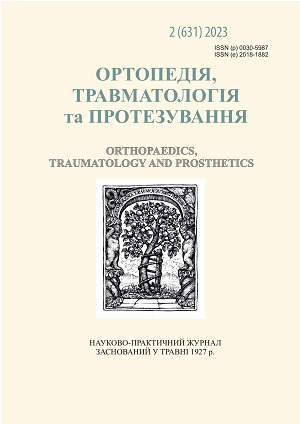STUDY OF THE INFLUENCE OF THE POSITION OF THE TENDON GRAFT HAMSTRING MUSCLE ON THE STABILITY OF THE KNEE JOINT UNDER THE CONDITIONS OF PLASTICITY OF THE STRUCTURES OF THE POSTEROLATERAL ANGLE
DOI:
https://doi.org/10.15674/0030-5987202325-12Keywords:
Knee jointAbstract
Damage to the posterolateral angle of the knee joint is an injury that occurs occasionally and can be isolated or combined with tears of the posterior or anterior cruciate ligaments. The key link of damage to the posterior lateral corner is the rupture of the tendon of the hamstring muscle, mained stabilizer of excess external rotation lower legs. Objective. Determine the optimal fixation position tendon graft on the posterior surface of the tibia subject to recovery of the hamstring muscle which ensuring the greatest stability of the lower leg during external rotation. Methods. Models of the knee joint were built with different attachment points of the popliteal graft muscle in the ANSYS software environment. The criteria for evaluating the effectiveness of selecting the fixation point of the transplant were chosen as the degree of movement of the finite parts elements of the model. Results. The smallest movements in all directions received in the case when the transplant fixed as far as possible outwards and upwards, near the joint surface. Maximum — in the direction of the coordinate axes, as well as full movement were recorded for the control model, in the absence of the hamstring tendon The nature of the distribution of displacement fields in all models p graft and control were identical. Biggest there were additional displacements in the direction of the x axis (outward). on the front border of the platform, and the largest negative (so far redins) on the back. The largest additional shifts to the sides the y (front) axes are fixed at the leftmost limit and the largest negative (back) — to the rightю Conclusions. In view of the stability of the lower leg during rotational loading, the most effective is fixation of the hamstring graft on the back surface of the fibula is as late as possible and closer to its cardiac surface, finished in this case, the dimensions are found to be the smallest in all directions. The greatest displacement in all directions obtained in the control model for less tendon hamstring muscle.
References
- Golovakha, M. L., Shyshka, I. V., Banit, О. V., Krasnoperov, S. N., Scbabus, R., & Orlianski, W. (2011). Effect of sagittal tibial slope on risk of anterior cruclate ligament lnjury. Herald of Orthopaedics, Traumatology and Prosthetics, (2), 34–38. Retried from: http://dspace.zsmu.edu.ua/bitstream/123456789/11686/1/Votip_2011_2_9.pdf (in russian)
- Golovakha, M., Bondarenko, S., & Orljanski, W. (2021). Results of minimally invasive knee posterolateral corner reconstruction. Orthopaedics, Traumatology and Prosthetics, (4), 13–21. https://doi.org/10.15674/0030-59872021413-21
- LaPrade, R. F, Ly, T. V., Wentorf, F. A., & Engebretsen, L. (2003). The posterolateral attachments of the knee: a qualitative and quantitative morphologic analysis of the fibular collateral ligament, popliteus tendon, popliteofibular ligament, and lateral gastrocnemius tendon. The American Journal of Sports Medicine, 31(6), 854‒860. http://doi.org/10.1177/03635465030310062101
- Triantafyllidi. E., Paschos, N. K., Goussia, A., Barkoula, N. M., Exarchos, D. A., Matikas, T. E., Malamou-Mitsi, V., & Georgoulis, A. D. (2013). The shape and the thickness of the anterior cruciate ligament along its length in relation to the posterior cruciate ligament: a cadaveric study. Arthroscopy, 29(12), 1963–1973. https://doi.org/10.1016/j.arthro.2013.09.007
- Cho, H.-J., Kwak, D.-S. (2020). Mechanical properties and characteristics of the anterolateral and collateral ligaments of the knee. Applied Sciences, 10(18), 6266. https://doi.org/10.3390/app10186266
- Logterman, S. L., Wydra, F. B., & Frank, R. M. (2018). Posterior cruciate ligament: anatomy and biomechanics. Current reviews in musculoskeletal medicine, 11(3), 510–514. https://doi.org/10.1007/s12178-018-9492-1
- Cone, S. G., Howe, D., & Fisher, M. B. (2019). Size and shape of the human anterior cruciate ligament and the impact of sex and skeletal growth: A Systematic Review. JBJS reviews, 7(6), e8. https://doi.org/10.2106/JBJS.RVW.18.00145
- LaPrade, R. F., Bollom, T. S., Wentorf, F. A., Wills, N. J., & Meister, K. (2005). Mechanical properties of the posterolateral structures of the knee. The American journal of sports medicine, 33(9), 1386–1391. https://doi.org/10.1177/0363546504274143
- Orozco, G. A., Tanska, P., Mononen, M. E., Halonen, K. S., & Korhonen, R. K. (2018). The effect of constitutive representations and structural constituents of ligaments on knee joint mechanics. Scientific reports, 8(1), 2323. https://doi.org/10.1038/s41598-018-20739-w
- Golovakhа, M. L, Orljanski, W, Benedetto, K. P., Panchenko, S., Büchler, P., Henle, P., & Aghayev, E. (2014). Comparison of theoretical fixation stability of three devices employed in medial opening wedge high tibial osteotomy: a finite element analysis. BMC Musculoskeletal Disorders, 15, 230. https://doi.org/10.1186/1471-2474-15-230
- Feodosiev, V. I. (1986). Strength of materials. Moscow: Nauka.
Downloads
How to Cite
Issue
Section
License

This work is licensed under a Creative Commons Attribution 4.0 International License.
The authors retain the right of authorship of their manuscript and pass the journal the right of the first publication of this article, which automatically become available from the date of publication under the terms of Creative Commons Attribution License, which allows others to freely distribute the published manuscript with mandatory linking to authors of the original research and the first publication of this one in this journal.
Authors have the right to enter into a separate supplemental agreement on the additional non-exclusive distribution of manuscript in the form in which it was published by the journal (i.e. to put work in electronic storage of an institution or publish as a part of the book) while maintaining the reference to the first publication of the manuscript in this journal.
The editorial policy of the journal allows authors and encourages manuscript accommodation online (i.e. in storage of an institution or on the personal websites) as before submission of the manuscript to the editorial office, and during its editorial processing because it contributes to productive scientific discussion and positively affects the efficiency and dynamics of the published manuscript citation (see The Effect of Open Access).














